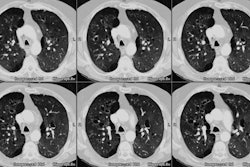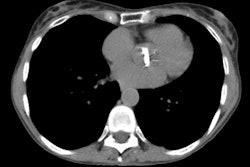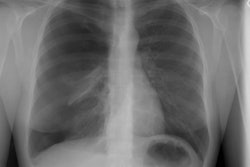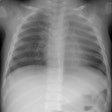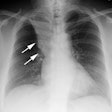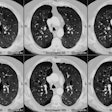Reperfusion edema after lung transplantation: radiographic manifestations.
Kundu S, Herman SJ, Winton TL
PURPOSE: To characterize the radiographic manifestations of reperfusion
edema after lung transplantation and to correlate
the severity of the radiographic findings with pulmonary physiology.
MATERIALS AND METHODS: Chest radiographs
obtained after 45 lung transplantation procedures (20 single, 25 double)
were reviewed retrospectively. Physiologic
parameters (alveolar-arterial gradient, ratio of partial pressure of
oxygen to fraction of inspired oxygen) were noted in
patients who underwent intubation. RESULTS: Reperfusion edema appeared
on day 1 in 39 transplants and by day 3 in 44.
One patient's lungs remained clear. Peak severity occurred by day 4
in 43 of 44 transplants. At peak severity, reperfusion
edema appeared as reticular interstitial disease in the upper (19%),
middle (33%), and lower (34%) lung zones or air-space
disease in the upper (31%), middle (61%), and lower (57%) zones. Reperfusion
edema was asymmetric after double-lung
transplantation in nine patients. The process cleared by day 10 in
five transplants and by day 21 in another seven. There was
a poor correlation between the severity of radiographic findings and
physiologic measurements. CONCLUSION:
Reperfusion edema is almost invariable after lung transplantation and
most often appears as air-space disease in the middle
and/or lower lung zones. The severity of radiographic findings is a
poor indicator of pulmonary physiology.

